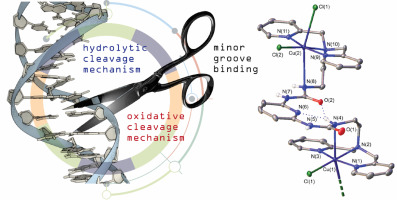当前位置:
X-MOL 学术
›
J. Inorg. Biochem.
›
论文详情
Our official English website, www.x-mol.net, welcomes your feedback! (Note: you will need to create a separate account there.)
Ditopic binuclear copper(II) complexes for DNA cleavage.
Journal of Inorganic Biochemistry ( IF 3.9 ) Pub Date : 2020-01-11 , DOI: 10.1016/j.jinorgbio.2020.110995 Israel Carreira-Barral 1 , Miguel Riopedre-Fernández 2 , Andrés de Blas 2 , Jesús Mosquera 3 , M Eugenio Vázquez 4 , Carlos Platas-Iglesias 2 , David Esteban-Gómez 2
Journal of Inorganic Biochemistry ( IF 3.9 ) Pub Date : 2020-01-11 , DOI: 10.1016/j.jinorgbio.2020.110995 Israel Carreira-Barral 1 , Miguel Riopedre-Fernández 2 , Andrés de Blas 2 , Jesús Mosquera 3 , M Eugenio Vázquez 4 , Carlos Platas-Iglesias 2 , David Esteban-Gómez 2
Affiliation

|
Herein we present the synthesis of two ligands containing two di(2-picolyl)amine (DPA) units linked by either a 1,1'-(pyridine-2,6-diyl)bis(3-ethylurea) (L1) or a 1,1'-(1,3-phenylene)bis(3-ethylurea) (L2) spacer. The corresponding binuclear CuII and ZnII complexes were prepared and isolated. The X-ray structures of the L1 ligand and the [Cu2L1Cl2]2+ complex evidence an unusual cis/trans conformation of one of the urea groups stabilized by an intramolecular hydrogen bond with the nitrogen atom of the pyridyl spacer. The CuII complexes form rather strong ternary complexes with phosphorylated anions. The [Cu2L1]4+ complex presents a rather high affinity for pyrophosphate (logK11 = 8.19 at pH 7, 25 °C), while [Cu2L2]4+ stands out because of its strong binding to AMP2- (logK11 = 9.3 at pH 7, 25 °C). The interaction of the CuII complexes with deoxyribonucleic acid from calf thymus (ct-DNA) was monitored using circular dichroism (CD) and luminescence spectroscopies. These studies revealed a quite strong interaction of the complexes with ct-DNA (Kb = (6.4 ± 0.7) × 103 for [Cu2L1]4+ and Kb = (6.3 ± 1.0) × 103 for [Cu2L2]4+). Competition experiments carried out in the presence of methyl green and BAPPA (N1,N3-Bis(4-amidinophenyl)propane-1,3-diamine) as major and minor groove competitors, respectively, confirm that the interaction of both complexes with DNA takes place through the minor groove, in agreement with docking studies. The [Cu2L2]4+ complex is quite efficient in promoting the cleavage of the double-stranded pUC19 plasmid DNA, by favoring the conversion of the supercoiled form to the nicked form following a hydrolytic mechanism.
中文翻译:

用于DNA切割的双位双核铜(II)配合物。
本文中,我们介绍了两个配体的合成,这些配体包含两个通过1,1'-(吡啶-2,6-二基)双(3-乙基脲)(L1)或1,1'-(1,3-亚苯基)双(3-乙基脲)(L2)间隔基。制备并分离了相应的双核CuII和ZnII复合物。L1配体和[Cu2L1Cl2] 2+配合物的X射线结构表明,通过一个分子内氢键与吡啶基间隔基的氮原子稳定的脲基之一具有不寻常的顺式/反式构型。CuII配合物与磷酸化的阴离子形成相当强的三元配合物。[Cu2L1] 4+复合物对焦磷酸盐具有相当高的亲和力(在pH 7、25°C时logK11 = 8.19),而[Cu2L2] 4+由于与AMP2-的牢固结合而突出(在pH 7时logK11 = 9.3)。 ,25°C)。使用圆二色性(CD)和发光光谱法监测CuII复合物与小牛胸腺中脱氧核糖核酸(ct-DNA)的相互作用。这些研究表明复合物与ct-DNA有很强的相互作用(对于[Cu2L1] 4 +,Kb =(6.4±0.7)×103,对于[Cu2L2] 4 +,Kb =(6.3±1.0)×103)。在分别作为主要和次要凹槽竞争者的甲基绿和BAPPA(N1,N3-双(4-ami基苯基)丙烷-1,3-二胺)的存在下进行的竞争实验证实了两种复合物与DNA的相互作用都需要与对接研究相一致,通过小凹槽放置。[Cu2L2] 4+复合物通过促进超螺旋形式向水解形式的切口形式的转化,在促进双链pUC19质粒DNA的切割中非常有效。
更新日期:2020-01-13
中文翻译:

用于DNA切割的双位双核铜(II)配合物。
本文中,我们介绍了两个配体的合成,这些配体包含两个通过1,1'-(吡啶-2,6-二基)双(3-乙基脲)(L1)或1,1'-(1,3-亚苯基)双(3-乙基脲)(L2)间隔基。制备并分离了相应的双核CuII和ZnII复合物。L1配体和[Cu2L1Cl2] 2+配合物的X射线结构表明,通过一个分子内氢键与吡啶基间隔基的氮原子稳定的脲基之一具有不寻常的顺式/反式构型。CuII配合物与磷酸化的阴离子形成相当强的三元配合物。[Cu2L1] 4+复合物对焦磷酸盐具有相当高的亲和力(在pH 7、25°C时logK11 = 8.19),而[Cu2L2] 4+由于与AMP2-的牢固结合而突出(在pH 7时logK11 = 9.3)。 ,25°C)。使用圆二色性(CD)和发光光谱法监测CuII复合物与小牛胸腺中脱氧核糖核酸(ct-DNA)的相互作用。这些研究表明复合物与ct-DNA有很强的相互作用(对于[Cu2L1] 4 +,Kb =(6.4±0.7)×103,对于[Cu2L2] 4 +,Kb =(6.3±1.0)×103)。在分别作为主要和次要凹槽竞争者的甲基绿和BAPPA(N1,N3-双(4-ami基苯基)丙烷-1,3-二胺)的存在下进行的竞争实验证实了两种复合物与DNA的相互作用都需要与对接研究相一致,通过小凹槽放置。[Cu2L2] 4+复合物通过促进超螺旋形式向水解形式的切口形式的转化,在促进双链pUC19质粒DNA的切割中非常有效。


























 京公网安备 11010802027423号
京公网安备 11010802027423号